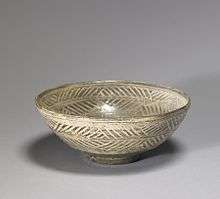Mishima ware
Mishima ware refers to different types of imported and adopted Japanese pottery. Mishima originally refers to the shimamono pottery imported from the islands of Taiwan, Luzon, and "Amakawa". They were characterized by being roughly-made and often uneven, thus epitomizing the Japanese aesthetic of wabi-sabi. In later centuries, it came to refer to imported ceramics (Gohon) from Korea with the slip inlay style. This style was imitated and produced locally in Japan.[1]

Shimamono Mishima
As described in the Tōkikō, Mishima (literally "three islands") originally referred to shimamono pottery imported from the islands of indigenous Taiwan, Luzon, and "Amakawa" (location unknown). Luzon Mishima (Rusuntsubo) were usually made from purple-black clay and usually had a green glaze. Native Taiwanese Mishima (Hagi Mishima) were made from light-colored clay and were decorated with a row of round knobs and had black marks on the bottom. Amakawa Mishima are made from white clay with a gray-colored glaze.[1]
Korean Mishima
In the 17th century, it was applied to the imported Korean slip inlay style pottery from Buncheong (then known specifically as Gohon), made at the instigation of the shōgun Tokugawa Iemitsu. The style of which goes back to Goryeo (935-1392) when bowls decorated in this way were known as Korai-jawan or Korai tea bowls.[2]
It was later imitated by kilns in Yamashiro Province. The copies were often imperfect, which is probably why they were later classified along with the traditional Mishima ware.[1]
In Gohon Mishima ware, bowls were inlaid with various motifs such as floral and animal depictions. To create these motifs, a potter would begin by engraving the design in the body. Next, the engravings would be filled with contrasting colored clay (or slip). Finally, the bowl is then covered it with a transparent glaze. This technique peaked in Korea during the 12th and 13th-century Goryeo celadons, deemed "first under heaven." It is also referred to as zogan.
Another inlay style is called reverse inlay. With this technique, the potter cuts away the background, leaving the design in relief. Then, with the design established, the background is brushed over with a slip. Finally, the excess is scraped away.
See also
- Onta ware, which also uses the slip technique
References
- Cole, Fay-Cooper (1912). "Chinese Pottery in the Philippines" (PDF). Field Museum of Natural History. Anthropological Series. 12 (1).
- Laufer, Berthold (1976-01-01). Kleinere Schriften: Publikationen aus der Zeit von 1911 bis 1925. 2 v. Otto Harrassowitz Verlag. ISBN 9783515026512.
External links
![]()
- The Mystery and the Mastery by Robert Yellin, The Japan Times, Oct 10, 2001.
- Mishima at About.com
- The Mystery and the Mastery - Japan Times article
